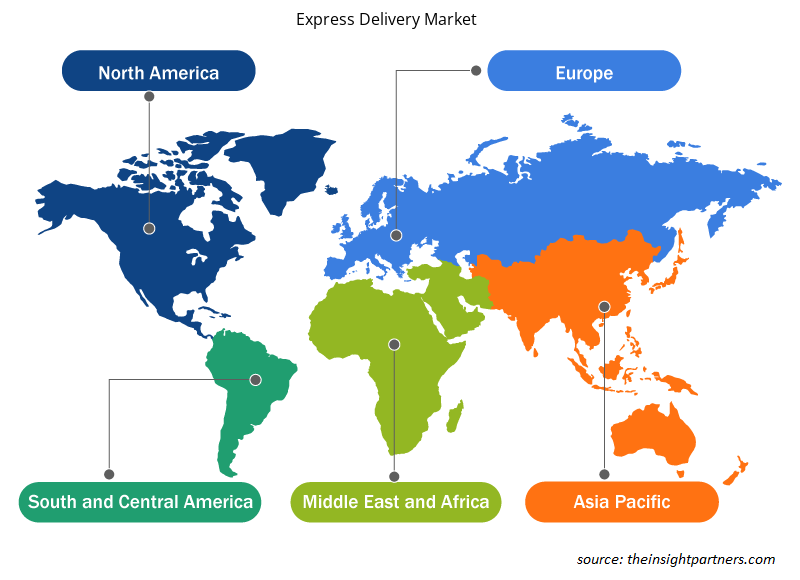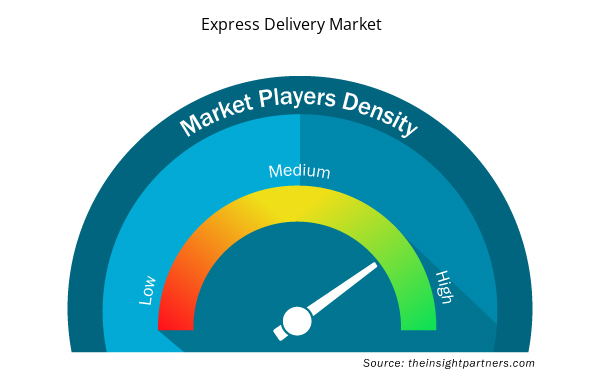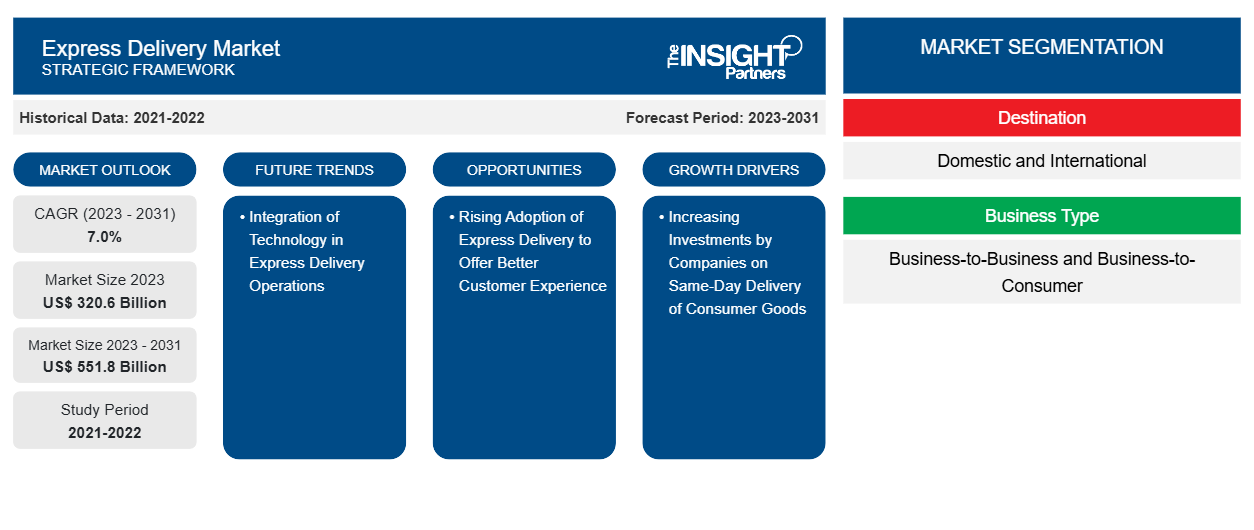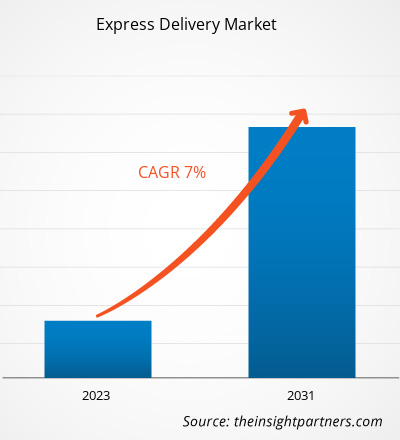Der Markt für Expresslieferungen soll von 320,6 Milliarden US-Dollar im Jahr 2023 auf 551,8 Milliarden US-Dollar im Jahr 2031 anwachsen. Der Markt soll in den Jahren 2023–2031 eine durchschnittliche jährliche Wachstumsrate von 7,0 % verzeichnen. Das rasante Wachstum der E-Commerce-Branche weltweit, der Anstieg der Kundenbasis für Online-Verkäufe und die weltweite Einführung von Expresslieferungen sind einige der Faktoren, die den Markt für Expresslieferungen antreiben.
Marktanalyse für Expresslieferungen
Aufgrund der zunehmenden Verbreitung des E-Commerce in der Weltbevölkerung dürfte der Markt für Expresslieferungen im analysierten Zeitraum beträchtlich wachsen. Die zunehmende Verbreitung von Smartphones und die hohe Internetdurchdringung weltweit wirken sich positiv auf die Verbreitung des E-Commerce-Sektors bei den weltweiten Kunden aus. Dies hat auch Unternehmen und Firmen dazu veranlasst, E-Verkaufskanäle oder Online-Kanäle zu nutzen, um eine größere Verbraucherbasis zu erreichen. Darüber hinaus beeinflusst die weltweite Verbreitung des Internets die Bevölkerung, Online-Käufe zu tätigen. Marken und E-Commerce-Websites nutzen in hohem Maße Expresslieferungen, um einen besseren Kundenservice zu bieten, indem sie Pakete in kürzerer Zeit zustellen.
Marktübersicht für Expresslieferungen
Der Markt für Expresslieferungen wächst rasant. Von der Lagerhaltung und Auftragsabwicklung bis hin zu Transport und Risikomanagement sind die Logistikanforderungen von Unternehmen aus den Bereichen Engineering und Fertigung (E&M) komplex. Da Bau-, Entwicklungs- und Infrastrukturprogramme weltweit zunehmen, spielt die Expresslieferung eine immer größere Rolle bei der Aufrechterhaltung des Betriebs und der Flexibilität dieser Unternehmen. Tatsächlich sind es die zunehmend globalen Aktivitäten in der Fertigungsindustrie sowie die zunehmende Entwicklung in den Schwellenmärkten, die den schnellen Warenverkehr so wichtig machen. Fabriken benötigen schnelle Lieferungen von Teilen und Maschinen, damit die Produktion nicht unterbrochen wird. Dieser Bedarf an Expresslieferungen in den Branchen wird in den kommenden Jahren voraussichtlich weiter steigen.
Passen Sie diesen Bericht Ihren Anforderungen an
Sie erhalten kostenlose Anpassungen an jedem Bericht, einschließlich Teilen dieses Berichts oder einer Analyse auf Länderebene, eines Excel-Datenpakets sowie tolle Angebote und Rabatte für Start-ups und Universitäten.
- Holen Sie sich die wichtigsten Markttrends aus diesem Bericht.Dieses KOSTENLOSE Beispiel umfasst eine Datenanalyse von Markttrends bis hin zu Schätzungen und Prognosen.
Regionale Einblicke in den Expressversandmarkt
Die regionalen Trends und Faktoren, die den Expressversandmarkt im Prognosezeitraum beeinflussen, wurden von den Analysten von Insight Partners ausführlich erläutert. In diesem Abschnitt werden auch die Marktsegmente und die Geografie des Expressversandmarkts in Nordamerika, Europa, im asiatisch-pazifischen Raum, im Nahen Osten und Afrika sowie in Süd- und Mittelamerika erörtert.

- Erhalten Sie regionale Daten zum Expressversandmarkt
Umfang des Marktberichts zum Expressversand
| Berichtsattribut | Details |
|---|---|
| Marktgröße im Jahr 2023 | 320,6 Milliarden US-Dollar |
| Marktgröße bis 2031 | 551,8 Milliarden US-Dollar |
| Globale CAGR (2023 - 2031)CAGR (2023 - 2031) | 7,0 % |
| Historische Daten | 2021-2022 |
| Prognosezeitraum | 2023–2031 |
| Abgedeckte Segmente | Nach Ziel
|
| Abgedeckte Regionen und Länder | Nordamerika
|
| Marktführer und wichtige Unternehmensprofile |
|
Marktteilnehmerdichte: Der Einfluss auf die Geschäftsdynamik
Der Markt für Expresslieferungen wächst rasant. Dies wird durch die steigende Nachfrage der Endnutzer aufgrund von Faktoren wie sich entwickelnden Verbraucherpräferenzen, technologischen Fortschritten und einem größeren Bewusstsein für die Vorteile des Produkts vorangetrieben. Mit der steigenden Nachfrage erweitern Unternehmen ihr Angebot, entwickeln Innovationen, um die Bedürfnisse der Verbraucher zu erfüllen, und nutzen neue Trends, was das Marktwachstum weiter ankurbelt.
Die Marktteilnehmerdichte bezieht sich auf die Verteilung von Firmen oder Unternehmen, die in einem bestimmten Markt oder einer bestimmten Branche tätig sind. Sie gibt an, wie viele Wettbewerber (Marktteilnehmer) in einem bestimmten Marktraum im Verhältnis zu seiner Größe oder seinem gesamten Marktwert präsent sind.
Die wichtigsten auf dem Expressversandmarkt tätigen Unternehmen sind:
- DHL International GmbH
- United Parcel Service of America, Inc.
- DSV A/S
- FedEx Corporation
- Geodis SA
- ARAMEX
Haftungsausschluss : Die oben aufgeführten Unternehmen sind nicht in einer bestimmten Reihenfolge aufgeführt.

- Überblick über die wichtigsten Akteure auf dem Expressversandmarkt
Nachrichten und aktuelle Entwicklungen auf dem Expressversandmarkt
Der Expressversandmarkt wird durch die Erhebung qualitativer und quantitativer Daten nach Primär- und Sekundärforschung bewertet, die wichtige Unternehmensveröffentlichungen, Verbandsdaten und Datenbanken umfasst. Im Folgenden finden Sie eine Liste der Entwicklungen auf dem Markt für Expressversand und der Strategien:
- Im Juni 2023 führte die Alibaba Logistics-Einheit Cainiao einen Expressdienst ein. Ziel ist es, die Effizienz des E-Commerce zu verbessern und den Verkauf über die E-Commerce-Plattform unter dem Markennamen Cainiao Express zu erleichtern.
- Im Januar 2021 kaufte Amazon.com, Inc. Jets, um seinen Traum einer 30-Minuten-Lieferung erfolgreich zu verwirklichen. Amazon kaufte 11 Boeing 767-300-Jets für die Luftfrachtabteilung, hauptsächlich um Produkte an Prime-Abonnenten zu liefern.
Marktbericht zum Expressversand – Abdeckung und Ergebnisse
Der Bericht „Marktgröße und Prognose für Expresslieferungen (2021–2031)“ bietet eine detaillierte Marktanalyse der folgenden Bereiche:
- Marktgröße und Prognose auf globaler, regionaler und Länderebene für alle wichtigen Marktsegmente, die im Rahmen des Projekts abgedeckt sind
- Marktdynamik wie Treiber, Beschränkungen und wichtige Chancen
- Wichtige Zukunftstrends
- Detaillierte Porter's Five Forces Analyse
- Globale und regionale Marktanalyse mit wichtigen Markttrends, wichtigen Akteuren, Vorschriften und aktuellen Marktentwicklungen
- Branchenlandschaft und Wettbewerbsanalyse, einschließlich Marktkonzentration, Heatmap-Analyse, prominenten Akteuren und aktuellen Entwicklungen
- Detaillierte Firmenprofile mit SWOT-Analyse
- Historische Analyse (2 Jahre), Basisjahr, Prognose (7 Jahre) mit CAGR
- PEST- und SWOT-Analyse
- Marktgröße Wert/Volumen – Global, Regional, Land
- Branche und Wettbewerbsumfeld
- Excel-Datensatz


- Analog-to-Digital Converter Market
- Public Key Infrastructure Market
- Personality Assessment Solution Market
- Smart Mining Market
- Queue Management System Market
- Clinical Trial Supplies Market
- Foot Orthotic Insoles Market
- Carbon Fiber Market
- Genetic Testing Services Market
- Point of Care Diagnostics Market

Report Coverage
Revenue forecast, Company Analysis, Industry landscape, Growth factors, and Trends

Segment Covered
This text is related
to segments covered.

Regional Scope
North America, Europe, Asia Pacific, Middle East & Africa, South & Central America

Country Scope
This text is related
to country scope.
Trends and growth analysis reports related to Automotive and Transportation : READ MORE..
The Insight Partners performs research in 4 major stages: Data Collection & Secondary Research, Primary Research, Data Analysis and Data Triangulation & Final Review.
- Data Collection and Secondary Research:
As a market research and consulting firm operating from a decade, we have published and advised several client across the globe. First step for any study will start with an assessment of currently available data and insights from existing reports. Further, historical and current market information is collected from Investor Presentations, Annual Reports, SEC Filings, etc., and other information related to company’s performance and market positioning are gathered from Paid Databases (Factiva, Hoovers, and Reuters) and various other publications available in public domain.
Several associations trade associates, technical forums, institutes, societies and organization are accessed to gain technical as well as market related insights through their publications such as research papers, blogs and press releases related to the studies are referred to get cues about the market. Further, white papers, journals, magazines, and other news articles published in last 3 years are scrutinized and analyzed to understand the current market trends.
- Primary Research:
The primarily interview analysis comprise of data obtained from industry participants interview and answers to survey questions gathered by in-house primary team.
For primary research, interviews are conducted with industry experts/CEOs/Marketing Managers/VPs/Subject Matter Experts from both demand and supply side to get a 360-degree view of the market. The primary team conducts several interviews based on the complexity of the markets to understand the various market trends and dynamics which makes research more credible and precise.
A typical research interview fulfils the following functions:
- Provides first-hand information on the market size, market trends, growth trends, competitive landscape, and outlook
- Validates and strengthens in-house secondary research findings
- Develops the analysis team’s expertise and market understanding
Primary research involves email interactions and telephone interviews for each market, category, segment, and sub-segment across geographies. The participants who typically take part in such a process include, but are not limited to:
- Industry participants: VPs, business development managers, market intelligence managers and national sales managers
- Outside experts: Valuation experts, research analysts and key opinion leaders specializing in the electronics and semiconductor industry.
Below is the breakup of our primary respondents by company, designation, and region:

Once we receive the confirmation from primary research sources or primary respondents, we finalize the base year market estimation and forecast the data as per the macroeconomic and microeconomic factors assessed during data collection.
- Data Analysis:
Once data is validated through both secondary as well as primary respondents, we finalize the market estimations by hypothesis formulation and factor analysis at regional and country level.
- Macro-Economic Factor Analysis:
We analyse macroeconomic indicators such the gross domestic product (GDP), increase in the demand for goods and services across industries, technological advancement, regional economic growth, governmental policies, the influence of COVID-19, PEST analysis, and other aspects. This analysis aids in setting benchmarks for various nations/regions and approximating market splits. Additionally, the general trend of the aforementioned components aid in determining the market's development possibilities.
- Country Level Data:
Various factors that are especially aligned to the country are taken into account to determine the market size for a certain area and country, including the presence of vendors, such as headquarters and offices, the country's GDP, demand patterns, and industry growth. To comprehend the market dynamics for the nation, a number of growth variables, inhibitors, application areas, and current market trends are researched. The aforementioned elements aid in determining the country's overall market's growth potential.
- Company Profile:
The “Table of Contents” is formulated by listing and analyzing more than 25 - 30 companies operating in the market ecosystem across geographies. However, we profile only 10 companies as a standard practice in our syndicate reports. These 10 companies comprise leading, emerging, and regional players. Nonetheless, our analysis is not restricted to the 10 listed companies, we also analyze other companies present in the market to develop a holistic view and understand the prevailing trends. The “Company Profiles” section in the report covers key facts, business description, products & services, financial information, SWOT analysis, and key developments. The financial information presented is extracted from the annual reports and official documents of the publicly listed companies. Upon collecting the information for the sections of respective companies, we verify them via various primary sources and then compile the data in respective company profiles. The company level information helps us in deriving the base number as well as in forecasting the market size.
- Developing Base Number:
Aggregation of sales statistics (2020-2022) and macro-economic factor, and other secondary and primary research insights are utilized to arrive at base number and related market shares for 2022. The data gaps are identified in this step and relevant market data is analyzed, collected from paid primary interviews or databases. On finalizing the base year market size, forecasts are developed on the basis of macro-economic, industry and market growth factors and company level analysis.
- Data Triangulation and Final Review:
The market findings and base year market size calculations are validated from supply as well as demand side. Demand side validations are based on macro-economic factor analysis and benchmarks for respective regions and countries. In case of supply side validations, revenues of major companies are estimated (in case not available) based on industry benchmark, approximate number of employees, product portfolio, and primary interviews revenues are gathered. Further revenue from target product/service segment is assessed to avoid overshooting of market statistics. In case of heavy deviations between supply and demand side values, all thes steps are repeated to achieve synchronization.
We follow an iterative model, wherein we share our research findings with Subject Matter Experts (SME’s) and Key Opinion Leaders (KOLs) until consensus view of the market is not formulated – this model negates any drastic deviation in the opinions of experts. Only validated and universally acceptable research findings are quoted in our reports.
We have important check points that we use to validate our research findings – which we call – data triangulation, where we validate the information, we generate from secondary sources with primary interviews and then we re-validate with our internal data bases and Subject matter experts. This comprehensive model enables us to deliver high quality, reliable data in shortest possible time.


 Holen Sie sich ein kostenloses Muster für diesen Bericht
Holen Sie sich ein kostenloses Muster für diesen Bericht